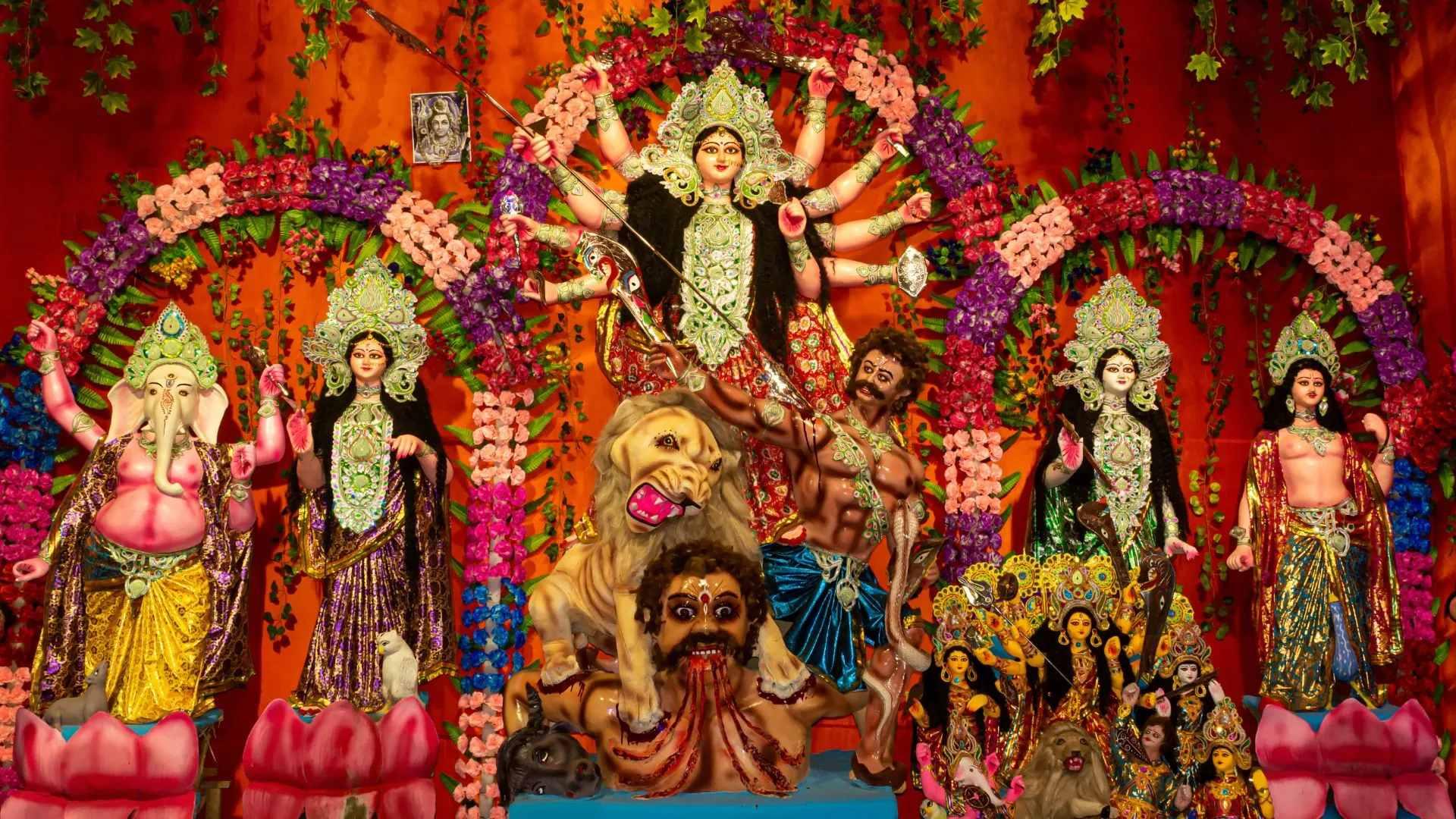Durga Puja: The Triumph of Good Over Evil
Durga Puja, one of the most grand and vibrant festivals of India, celebrates the victory of good over evil through the worship of Goddess Durga. It is a festival steeped in mythological significance, cultural traditions, and regional variations, bringing together millions of people in joyous celebration every year, particularly in the states of West Bengal, Assam, Odisha, and Bihar. The festival not only marks the victory of Goddess Durga over the demon Mahishasura but also represents the eternal battle between good and evil that resonates across cultures and religions.
The Mythological Roots of Durga Puja
The roots of Durga Puja lie in ancient Hindu mythology. According to the legend, Mahishasura, a powerful demon, had acquired immense strength and had become invincible. His rule over the heavens and earth caused suffering among the gods and humans. Desperate to end his reign, the gods summoned Goddess Durga, a divine form created from their combined powers, to defeat the demon. Durga, mounted on a lion and armed with weapons bestowed upon her by each deity, engaged in a fierce battle with Mahishasura. After nine days of intense combat, Durga emerged victorious, slaying the demon on the tenth day, known as Vijaya Dashami.
This battle symbolizes the triumph of virtue, truth, and righteousness over sin, tyranny, and darkness. The victory of Durga is celebrated not only as a religious event but also as a message of hope, courage, and the ultimate triumph of good.
The Festivities: Rituals and Celebrations
Durga Puja is a festival that spans several days, with each day holding special significance. The celebrations typically begin on the sixth day of the Navaratri festival and culminate on the tenth day, Vijaya Dashami, marking the victory of Durga. Here’s a look at some of the key rituals and events during this period:
-
Mahalaya: The festivities begin with Mahalaya, which marks the start of Durga Puja. On this day, devotees chant mantras to invoke the Goddess and invite her to descend to the earth. Mahalaya is a day of remembrance and is often marked by the broadcast of the devotional program ‘Mahalaya’ on radio, which sets the tone for the celebrations.
-
Saptami to Navami: The main days of Durga Puja are Saptami (the seventh day), Ashtami (the eighth day), and Navami (the ninth day). On these days, elaborate prayers (pujas) are conducted, including the offering of flowers, fruits, and sweets to Goddess Durga. Traditional rituals such as "kumari puja" (worship of young girls symbolizing the goddess) and "sandhi puja" (a special ritual at the juncture of Ashtami and Navami) are performed with great reverence.
-
The Idol and Decorations: Durga Puja is famous for the beautiful idols of Goddess Durga, often made of clay and adorned with intricate decorations. The idols typically depict Durga in her victorious stance, slaying the demon Mahishasura. These idols are placed in elaborately decorated pandals (temporary structures), which are sometimes designed to reflect modern themes, social issues, or artistic expressions. The creativity and craftsmanship involved in making the idols and pandals are a highlight of the celebrations.
-
Cultural Events: Durga Puja is not just a religious observance; it is also a time for cultural activities. From traditional dance performances like Durga Puja dances and Dhunuchi Naach (a dance with incense burners), to art exhibitions, music, and theatre performances, the festival brings together people of all ages and backgrounds. The streets are filled with music, laughter, and festivity.
-
Sindoor Khela and Vijayadashami: On the last day of Durga Puja, women participate in the ritual of Sindoor Khela, where they apply sindoor (vermilion) to the Goddess and to each other. This marks the end of the celebrations and the start of the farewell to the Goddess. The immersion (visarjan) of the Durga idol in rivers or other bodies of water is the final act, symbolizing her return to her divine abode and a cycle of renewal and purification.
Cultural and Social Significance
While Durga Puja is inherently a religious festival, it also holds great cultural and social importance. It is a time when people from all walks of life come together to celebrate their shared heritage and traditions. The festival fosters a sense of unity, community, and belonging. Streets are filled with pandals, and the air is alive with joy and enthusiasm. Families and friends gather to celebrate, eat, dance, and worship together.
Durga Puja also represents the strength and resilience of women. The figure of Goddess Durga, fierce and powerful, is a symbol of feminine power, embodying qualities such as bravery, determination, and wisdom. In recent years, there has been a growing recognition of the importance of empowering women, and Durga Puja has become a platform for raising awareness about women’s rights and gender equality.
The Global Appeal of Durga Puja
While Durga Puja is most widely celebrated in India, its reach has expanded far beyond the subcontinent. Bengali communities across the world, particularly in countries like the United States, Canada, the United Kingdom, and Australia, hold their own Durga Puja celebrations, often drawing large crowds. The global nature of the festival reflects not only the Indian diaspora's connection to their roots but also the universal appeal of the festival's message of hope and triumph.
Conclusion
Durga Puja is a celebration that transcends mere ritual; it is an embodiment of the human spirit’s capacity to overcome adversity, celebrate life, and honor the divine. The festival is a reminder that, no matter how powerful the forces of evil may seem, the strength of virtue and goodness will always prevail. The celebration of Goddess Durga’s victory resonates with people of all faiths, making it a timeless festival that continues to inspire millions across the world.

